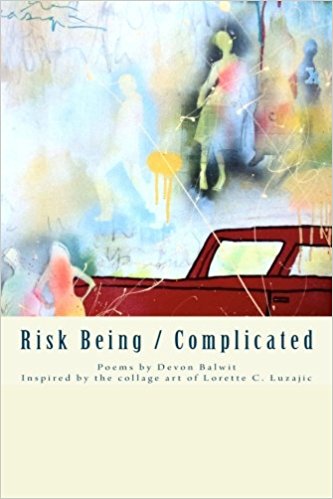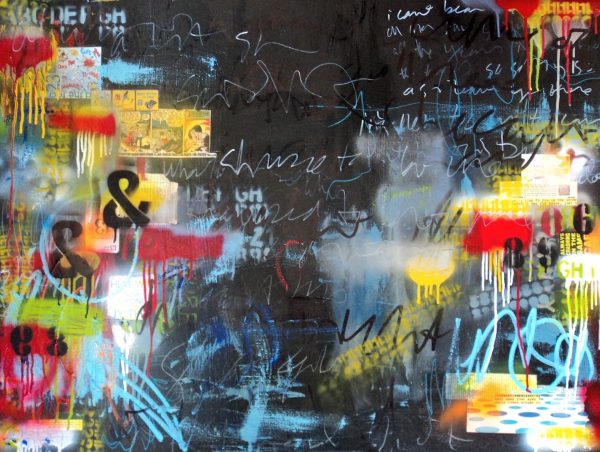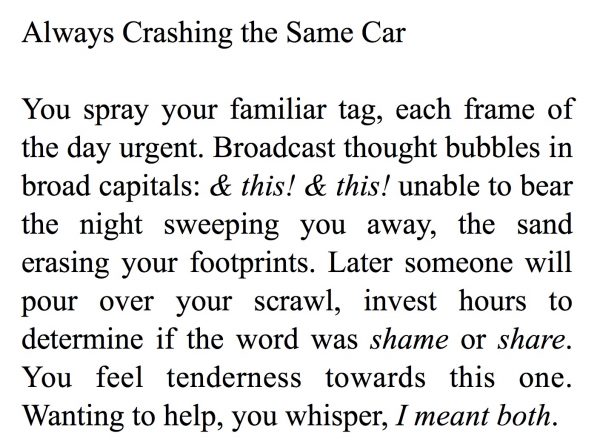
Risk Being / Complicated
by Devon Balwit
Paperback: 78 pages
Publisher: CreateSpace Independent Publishing Platform (January 31, 2018)
ISBN-13: 978-1981800971
Amazon
*
Devon Balwit’s Risk Being / Complicated is a book of poems inspired by the collage art of Lorette C. Luzajic. The slash that is found floating in the title prepares the reader for the gratifying journey through a book that is both and/or. It is a book of collage art and/or a book of poems. The art works with/or without the poems, and the poems work with/or without the art; but the two together provide a uniquely rich experience. The art and poems inside are risky, in the sense that they don’t seek to tell us what to make of them, but allow the reader room in which to explore, enjoy, and ask questions. There are no easy answers to be found here, and since many of the collages offer only partial words or words that we cannot quite decipher, the poems give an additional layer of meaning without telling us what anything “means.” Perhaps this is the reason for the second part of the title, “Complicated,” however the contents are complicated in the clearest sense; not seeking to obscure meaning, but creating more of it by layering poem with art, blending two voices where we would usually have only one. The poems are enriched by the collages, and the collages offer interesting visual representations for choices being made in each of the poems. The triangulation of reader, poet, and artist adds texture to the reading of the work, allowing the unexpected to emerge.
According to her website, Luzajic uses mixed media in her collages, “redefining the term to include concepts and ideas as well as tangible physical materials.” Luzajic employs a multitude of materials such as paint, chalk, crayon, plaster, glue, found paper (some with text) to piece together fantastically imaginative, colorful, thought-provoking works of art. Poetry itself is a kind of collage, where images, words, lines, structure, experiences, memory, and text are pieced together and then revised until the desired effect is achieved. Balwit’s materials include the collages that inspire and guide her; her history of reading and writing; and the devices of poetry, which she employs with admirable skill. Even her dedication “to the many artists whose work has inspired me,” speaks to the assemblage of voices that influence and instigate the poetry offered here, the collage of art created before this collection that has come together to allow this new material to surface.
The title poem, “Risk Being / Complicated” comes on page 31, in the middle of the collection, and uses Luzajic’s collage “The Risk of Being Complicated” as its springboard. The poem is written in seven unrhymed couplets that utilize the slash several times, perhaps to call attention to the multiple ways words can be read on the page. For example, the line “You vow to embrace yourself as you would any dying / animal” places the slash between dying and animal so that the line suggests “You vow to embrace yourself as you would any dying” or “You vow to embrace yourself as you would any animal” or “You vow to embrace yourself as you would any dying animal.” Each way of reading is a new way of seeing the line, just as each layer of material in a collage provides a layer that adds to how we see the whole. The last three couplets summarize what may be the desire of this book of poems:
You plunge into fog and lose yourself
further, joyfully / indefinite,
let words unravel like laddering tights,
gapping to reveal warm / flesh.
The inchoate used to terrify. Now
it becomes / where you choose to live.
These poems are a place in which to “lose yourself,” and yet there is the human that comes peeking through the words and always has a presence there, like the “laddering tights” that give us glimpses of the flesh. The “inchoate,” that is what is not fully formed or that which has just begun, is exactly where this art and these poems lead us, leaving us space to form the rest of the story, or perhaps several other stories. In one interview, Balwit discusses how her work has changed from being mostly autobiographical to more exploratory. This is not a book of poems that tells us how to look at art, but rather, gives us an opening, a pair of fresh eyes, a different way of looking, not just at each collage, but also at the world and our place in it.
Balwit uses metaphor to express the ineffable. For example, in the collage Run, Rabbit, Run, Luzajic renders a strange figure with long ear-like appendages. Balwit puts words to these appendages, calling them both rabbit ears and a crown: “Some days you are king, others / a rabbit, crown-ears pricked…”. In this way, Balwit is able to capture the idea that we are both important and trivial, both “processional” and “clinging to life.”
Balwit does not use form in a traditional way, instead employing form so that it is not the main material of the poem but one of the many materials. The first poem in the collection, titled “(Never) Let Yourself Forget How Your Story Began,” is fourteen lines like a traditional sonnet, but not written in iambic pentameter. Also, the poem is set up like a prose poem, with edges that are even rather than jagged. In this sense, the poem shows that it is constrained to the page, just as a collage or any work of art is constrained to the canvas on which it is created. And yet, because the poem goes so many places (from references to comics like Blondie to linguistic-themed words like “glottals,” “fricatives,” and “palatals”), it feels vast and unconstrained. The collage that prompted this poem, Let Yourself Forget How Your Story Began, has the bounds of its canvas, which is square; and yet the materials used within the collage are scattered in these bounds, dripping down the canvas, almost wildly. Form works paradoxically here to both contain the artwork within boundaries while allowing it to explode with meanings. Balwit also employs form to both bound the text and open up new possibilities within it, skillfully using the form of the Golden Shovel to “glue” lines from the biblical Song of Solomon, “Place Me Like a Seal Over Your Heart…” into the right margin of the poem, growing a new poem from the roots of a previous text, in the same way as a collage artist makes use of previous materials and repurposes them to create new artwork.
Balwit’s collection is an inspired one. The components of art: form, shape, line, color, value, space, and texture are beautifully executed in both the collages and in the poems. There is much to admire. Balwit’s poems sing. Take for example the phrases “If you still risk the hinge / of my thighs,” “Beach glass abrades to amulet,” and “the universe unbuttoning.” In this collection, the universe is unbuttoned, and we are allowed to joyfully explore not just collage art and not just poetry, but what art and poetry have been, what art and poetry are, and what art and poetry are capable of.


(Featured Image: “I Just Had to Give You Back to the Sea,” collage by Lorette C. Luzajic.)
[alert type=alert-white ]Please consider making a tax-deductible donation now so we can keep publishing strong creative voices.[/alert]
